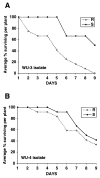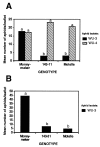The nematode resistance gene Mi of tomato confers resistance against the potato aphid
- PMID: 9707547
- PMCID: PMC21408
- DOI: 10.1073/pnas.95.17.9750
The nematode resistance gene Mi of tomato confers resistance against the potato aphid
Abstract
Resistance against the aphid Macrosiphum euphorbiae previously was observed in tomato and attributed to a novel gene, designated Meu-1, tightly linked to the nematode resistance gene, Mi. Recent cloning of Mi allowed us to determine whether Meu-1 and Mi are the same gene. We show that Mi is expressed in leaves, that aphid resistance is isolate-specific, and that susceptible tomato transformed with Mi is resistant to the same aphid isolates as the original resistant lines. We conclude that Mi and Meu-1 are the same gene and that Mi mediates resistance against both aphids and nematodes, organisms belonging to different phyla. Mi is the first example of a plant resistance gene active against two such distantly related organisms. Furthermore, it is the first isolate-specific insect resistance gene to be cloned and belongs to the nucleotide-binding, leucine-rich repeat family of resistance genes.
Figures




Comment in
-
The molecular mechanisms responsible for resistance in plant-pathogen interactions of the gene-for-gene type function more broadly than previously imagined.Proc Natl Acad Sci U S A. 1998 Aug 18;95(17):9711-2. doi: 10.1073/pnas.95.17.9711. Proc Natl Acad Sci U S A. 1998. PMID: 9707538 Free PMC article. No abstract available.
Similar articles
-
The tomato Mi-1 gene confers resistance to both root-knot nematodes and potato aphids.Nat Biotechnol. 1998 Dec;16(13):1365-9. doi: 10.1038/4350. Nat Biotechnol. 1998. PMID: 9853621
-
Heterologous expression of the Mi-1.2 gene from tomato confers resistance against nematodes but not aphids in eggplant.Mol Plant Microbe Interact. 2006 Apr;19(4):383-8. doi: 10.1094/MPMI-19-0383. Mol Plant Microbe Interact. 2006. PMID: 16610741
-
Quantitative differences in aphid virulence and foliar symptom development on tomato plants carrying the Mi resistance gene.Environ Entomol. 2007 Apr;36(2):458-67. doi: 10.1603/0046-225x(2007)36[458:qdiava]2.0.co;2. Environ Entomol. 2007. PMID: 17445382
-
Tomato Natural Resistance Genes in Controlling the Root-Knot Nematode.Genes (Basel). 2019 Nov 14;10(11):925. doi: 10.3390/genes10110925. Genes (Basel). 2019. PMID: 31739481 Free PMC article. Review.
-
Plant resistance to aphid feeding: behavioral, physiological, genetic and molecular cues regulate aphid host selection and feeding.Pest Manag Sci. 2014 Apr;70(4):528-40. doi: 10.1002/ps.3689. Epub 2014 Jan 15. Pest Manag Sci. 2014. PMID: 24282145 Review.
Cited by
-
Genetic mapping of a novel gene for soybean aphid resistance in soybean (Glycine max [L.] Merr.) line P203 from China.Theor Appl Genet. 2013 Sep;126(9):2279-87. doi: 10.1007/s00122-013-2134-5. Epub 2013 Jun 11. Theor Appl Genet. 2013. PMID: 23754637
-
Epigenetic and Metabolic Changes in Root-Knot Nematode-Plant Interactions.Int J Mol Sci. 2020 Oct 20;21(20):7759. doi: 10.3390/ijms21207759. Int J Mol Sci. 2020. PMID: 33092207 Free PMC article.
-
Dual disease resistance mediated by the immune receptor Cf-2 in tomato requires a common virulence target of a fungus and a nematode.Proc Natl Acad Sci U S A. 2012 Jun 19;109(25):10119-24. doi: 10.1073/pnas.1202867109. Epub 2012 Jun 6. Proc Natl Acad Sci U S A. 2012. PMID: 22675118 Free PMC article.
-
A single gene, AIN, in Medicago truncatula mediates a hypersensitive response to both bluegreen aphid and pea aphid, but confers resistance only to bluegreen aphid.J Exp Bot. 2009;60(14):4115-27. doi: 10.1093/jxb/erp244. Epub 2009 Aug 18. J Exp Bot. 2009. PMID: 19690018 Free PMC article.
-
A maize resistance gene functions against bacterial streak disease in rice.Proc Natl Acad Sci U S A. 2005 Oct 25;102(43):15383-8. doi: 10.1073/pnas.0503023102. Epub 2005 Oct 17. Proc Natl Acad Sci U S A. 2005. PMID: 16230639 Free PMC article.
References
-
- Kok-Yokomi M L. Ph.D. thesis. Davis: University of California; 1978.
-
- Braithwaite B M, Blake C D. Aust J Agric Res. 1961;12:1100–1107.
-
- Smith P G. Proc Am Soc Hortic Sci. 1944;44:413–416.
-
- Medina-Filho H P, Tanksley S D. In: Handbook of Plant Cell Culture. Evans D A, Sharp W R, Ammirato P V, Yamada Y, editors. Vol. 1. New York: MacMillan; 1983. pp. 904–923.
Publication types
MeSH terms
Substances
Associated data
- Actions
- Actions
- Actions
LinkOut - more resources
Full Text Sources
Other Literature Sources

